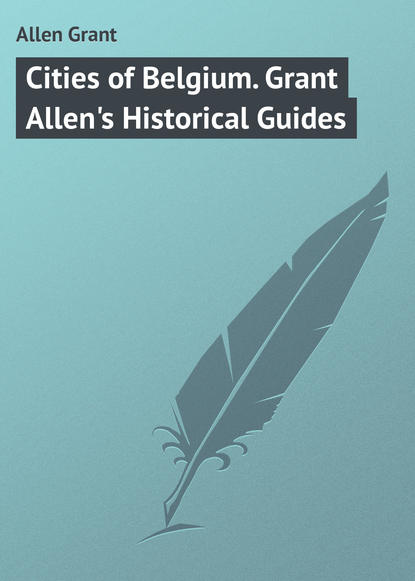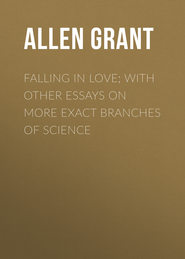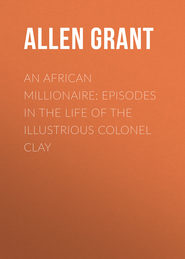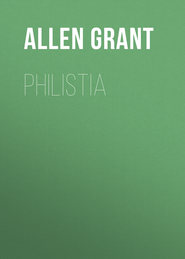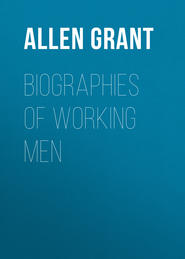По всем вопросам обращайтесь на: info@litportal.ru
(©) 2003-2024.
✖
Cities of Belgium. Grant Allen's Historical Guides
Настройки чтения
Размер шрифта
Высота строк
Поля
Second chapel, of the Armourers, has a railing with arms and cannon, and contains an old blackened crucifix, much venerated because it is said to have caught a thief who had entered the church to steal the treasures.
The pulpit is a carved wooden monstrosity of the 18th century, representing, behind, the Repentance of Peter, with the cock crowing, a maladroit subject for a church dedicated to the saint. In front, the Conversion of St. Paul, with his horse overthrown. Above are two palm trees.
The Choir is separated from the Transepts and Nave by a very handsome and elaborate *Rood-Loft, in the finest flamboyant late-Gothic style (1450), one of the best still remaining examples in Europe. It supports a Crucifixion, with St. John and Our Lady. Its arcade of three handsome arches is surmounted by a sculptured balustrade, containing figures of saints (the Saviour, Our Lady and Child, the Twelve Apostles with the instruments of their martyrdom, the Doctors of the Church, and a few others). Examine carefully.
Now, pass behind the Choir, into the Ambulatory, beginning on the N., or left side. The first recess has a fine mediæval tomb of Mathilde de Flandre. On your R., in the Choir, a little further on, is a beautiful late-Gothic tabernacle or canopy of 1450, gilded, and containing scenes from the Passion. Just behind the High Altar is a curious little 15th century relief: Centre, the Crucifixion with St. John and Our Lady: R., The Resurrection, with sleeping Roman soldiers: L., The donor, with his patron St. John the Baptist.
The first chapel beyond the High Altar contains **The Last Supper, by Dierick Bouts. This picture forms the central piece of a triptych, painted for the Confraternity of the Holy Sacrament. The L. wing of it is now at Munich, and the R. at Berlin. It represented, when entire, the same mystical series of the Institution of the Eucharist which we have already seen in the Pourbus of the Cathedral at Bruges. The central panel represented the Institution of the Eucharist; the L. (Munich) has Melchizedeck offering bread and wine to Abraham; the R. (Berlin) Elijah fed by ravens in the wilderness. On the outer sides of the panels are two similar typical subjects: L. (Munich), the Gathering of the Manna or food from Heaven; and R. (Berlin), the Feast of the Passover, the Paschal Lamb being regarded as a type of the Christian sacrifice. The picture as it stands in this chapel has of course lost its mystical significance. It closely resembles the smaller Last Supper in the Brussels Gallery; but the architecture here is Gothic, not Renaissance. Study well, especially the figures of the donor (by the door) and the servant. The floor is characteristic.
Also a **triptych, by Dierick Bouts, the Martyrdom of St. Erasmus, patron against intestinal diseases: a bishop, martyred at Formia in the persecution of Diocletian. It represents the hideous episode of the unwinding of the saint’s bowels. The executioner on the L. is a good specimen of Dierick Bouts’s rude artisan figures; he looks like a cobbler. In the background is the Emperor Diocletian, richly attired, with a courtier, whose attitude recalls more than one of those in the Justice of Otho. The landscape is characteristic of Bouts’s manner. This is a good, hard, dry picture. The L. panel has St. Jerome, robed as cardinal, with his lion; the R. has St. Anthony, accompanied by a vanquished demon. This, however, is a St. Anthony as the abbot, not as the hermit in the desert.
On the roof of the fourth chapel have recently been discovered some frescoes, from which the plaster and whitewash is now being removed.
In the chapel next it to the R. is a triptych, the Descent from the Cross (covered, the Sacristan will open it: 1 franc); usually attributed to Roger van der Weyden, but much disputed. It is probably a smaller (altered) copy of the famous composition in the Escurial at Madrid (see Conway). The central picture has Christ supported by Joseph of Arimathea and Nicodemus, with the fainting Madonna, St. John, and the other Maries. The singularly unpleasing fat cook-like Magdalen, in a rich robe, is a constant feature in the group of Descents from the Cross by Roger and his pupils. Study this picture. The L. panel has a good portrait of the donor, with his two sons, accompanied by his patron St. James the Greater (or St. William?). The R. panel has his wife, with her two daughters and her patroness, St. Adelaide (or St. Elizabeth of Hungary, holding the crown which she gave up for the Franciscan profession?).
In the sixth chapel is a fine Renaissance tomb, representing Adolf van Baussede in adoration before the Trinity, introduced by his patron St. Adolphus, with allegorical figures of Faith, Hope, and Charity. The work is almost Italian in character.
Over the High Altar is a modern figure of the patron, St. Peter, enthroned as pope, and with papal symbols behind him. Left of it is the fine canopy we have already observed from the outside, with scenes from the Passion. The architecture here is striking.
The great Quentin Matsys of the Family of St. Anne in the Brussels Picture Gallery was formerly an altar-piece in this church.
There is nothing else at Louvain that need detain you. If you like, you can stroll a little way down the Rue de Namur, just to the R. of the Hôtel-de-Ville. It contains some good old houses. The desolate building on your R. was originally the Halles, but is now the University. It was built for the Guild of Clothmakers in 1317, and has been wholly modernised; but there are some good Gothic arches on the basement floor within (approach down the side street to the R.). Further on is the Collège du St. Esprit on the R., and the Church of St. Michel (uninteresting) on the L. The street which here runs off obliquely conducts to the Collège Marie-Thérèse, and the Collège Adrien VI., uninteresting, and all used as hostelries for the students. The only other objects to look at in Louvain are the choir-stalls in carved wood, early Renaissance, at the Church of St. Gertrude, dedicated to the Abbess of Nivelles and aunt of St. Gudula. It lies down the Rue de Malines, in the opposite direction from the Rue de Namur. You have then seen Louvain.
On your way from Brussels to Antwerp, you ought to visit Malines Cathedral. The easiest way is to book your luggage through, and then stop for an hour or two at Malines, going on by a later train.
IV
ANTWERP
A. ORIGINS OF ANTWERP
ANTWERP, the seaport of the Schelde estuary, is practically the youngest (and the least interesting) of the great Belgian towns. It should therefore be visited last by the historically-minded tourist. A small town, known in Flemish as Antwerpen (“at the Wharf”), – a name altered in French and English into Anvers and Antwerp, – existed here, it is true, as early as the 7th century, and suffered heavily in the 9th from the ubiquitous Northmen. But its situation at the open mouth of the great estuary of the Schelde, exposed to every passing piratical invader, rendered it unfit for the purposes of early commerce. The trade of Flanders, in its first beginnings, accordingly concentrated itself in the more protected inland ports like Bruges and Ghent; while that of Brabant, of which province Antwerp itself formed a part, found a safer home in Brussels or Louvain, far up some minor internal river. Hence the rise of Antwerp dates no further back than the end of the 15th and beginning of the 16th century.
Its rise, that is to say, as a great commercial port, for from an early period it was the capital of a petty margrave, under the Duke of Brabant. As northern Europe grew gradually quieter during the 11th and 12th centuries, Antwerp rose somewhat in importance; and the magnificence of its cathedral, the earliest part of which dates from 1352, sufficiently shows that the town was increasing in wealth and population during the palmy period when Bruges and Ghent governed the trade of the Continent. But when, in the 15th century and the beginning of the 16th, Bruges began to decline (partly from political causes, but more still from changes in navigation and trade routes), Antwerp rose suddenly to the first position in the Low Countries and perhaps in Europe. Its large, deep, and open port was better adapted to the increasing shipping of the new epoch than were the shallow and narrow canals or rivers of Ghent, Bruges, and Brussels. The discovery of America, and of the route to India by the Cape of Good Hope, had revolutionized both commerce and navigation; vessels were built larger and of deeper draught; and the Schelde became for a time what the Thames, the Clyde, and the Mersey have become in our own period. Antwerp under Charles V. was probably even more prosperous and wealthier than Venice. The centre of traffic was shifting from the Mediterranean to the Atlantic seaboard. The city reached its highest point of prosperity about 1568, when it is said that thousands of vessels lay at anchor in the Schelde, and that more than a hundred craft sailed and arrived daily. Even allowing for the smaller burden of those days, however, this is probably an exaggeration. The great fairs of Antwerp, of which those of Leipzig and Nijni Novgorod are now the only modern representatives, also drew thousands of merchants from all parts of the world. The chief imports were wool and other agricultural produce from England, grain from the Baltic, wines from France and Germany, spices and sugar from Portuguese territory, and silks and Oriental luxuries from Venice and other parts of Italy. The exports were the manufactured goods of Flanders and Brabant, countries which still took the lead in textile fabrics, tapestries, carpets, and many other important industries.
It is to this late period of wealth and prosperity that Antwerp owes most of the great buildings and works of art which still adorn it. Its cathedral, indeed, varies in date in different parts from the middle of the 14th to the beginning of the 16th century, and some portions were not quite completed till the 17th; but the general aspect of the core of the town is of the Renaissance epoch. It contains in its modern gallery not a few Flemish paintings of the earlier period, produced by the artists of Ghent, Bruges, and Brussels; but its own native art dates no further back than Quentin Matsys (1466-1531), the last of the painters of the Netherlands who adhered to the national type of art; while it reached its highest point in Rubens (1577-1640), who introduced into the Low Countries the developed style of the Italian Renaissance, adapted and strained through an essentially robust Flemish nature. It is only at Antwerp that these two great masters can be studied to the highest advantage; they illustrate, one the rise, the other the culmination and after-glow, of the greatness of their native city. I say native advisedly, for though Rubens most probably was born at Siegen (in Nassau), he was an Antwerper by descent, by blood, by nature, and by residence.
The decline of the city in later times was due to a variety of concurrent causes, some of them strangely artificial, which long distracted trade from one of its most natural outlets in Europe. The Spanish troops began the devastation, during the abortive attempt of the southern provinces to shake off the yoke of Spain; in 1576, the Town Hall and nearly a thousand noble buildings were burnt, while 8,000 people were ruthlessly massacred. In 1585, the Duke of Parma completed the destruction of the local prosperity: the population was largely scattered, and the trade of Antwerp completely ruined. The long and unsuccessful rebellion, the division which it unhappily caused between Holland and Belgium, and the rapid commercial rise, first of Amsterdam and then of England, all contributed to annihilate the mercantile importance of Antwerp. The Dutch erected forts on their own territory at the mouth of the Schelde, and refused to allow shipping to proceed up the river. Finally by the Treaty of Munster in 1648 it was agreed that no sea-going vessel should be allowed to ascend the estuary to Antwerp, but that all ships should unload at a Dutch port, goods being forwarded by river craft to the former capital of European commerce. From that date forward to the French occupation in 1794, Antwerp sank to the position of a mere local centre, while Rotterdam and Amsterdam took its place as commercial cities. In the latter year, however, the French reopened the navigation of the Schelde, and destroyed the iniquitous Dutch forts at the entrance to the river. Napoleon, in whose empire the town was included, constructed a harbour and built new quays; but after his fall, Antwerp was made over to Holland, and began to trade as a Dutch seaport. The erection of Belgium into a separate kingdom in 1830 again told against it, as the Dutch maintained their unjust power of levying tolls on the shipping; in addition to which drawback, Antwerp had suffered heavily from siege during the War of Independence. In 1863, however, the Dutch extortioners were bought off by a heavy money payment, and Antwerp, the natural outlet of the Schelde, and to a great extent of the German empire, once more regained its natural place as a main commercial port of Europe. Since that date, its rise has been extraordinarily rapid, in correspondence with the large development of Belgian manufactures and still more with the new position of Germany as a world-trading power. Indeed, nothing but the artificial restrictions placed upon its commerce by the selfishness and injustice of the Dutch could ever have prevented the seaport of the Schelde from ranking as one of the chief harbours of the world, as soon as ocean-going ships demanded ports of that size, and as commerce had no longer anything to fear from marauding pirates.
As a consequence of these conditions, we have to expect in Antwerp mainly a central town of the 15th and 16th centuries, with an immense modern outgrowth of very recent origin. Save its fine Cathedral, and its imported pictures, it has little or nothing of mediæval interest.
The population of Antwerp is almost entirely Flemish, though French is the language of the higher commerce; and the town is the stronghold of the old Flemish feeling in Belgium, as opposed to the Parisian tone of Brussels.
Concurrently with the rise of its renewed commercial importance, Antwerp has become once more a centre of Belgian art, and especially of the pure Flemish school of archaists, who have chosen their subjects from Flemish history, and followed to some extent the precedents of the early Flemish painters. Examples of these will meet us later.
Choose an hotel on the Place Verte, if possible, or at least very near it. You cannot gain a first impression of Antwerp in less than four or five days.
Antwerp is a confused town, a maze without a plan: till you have learnt your way about, I advise you to follow the tram-lines: you will thus avoid the slummy streets which abound even in the best quarter.
B. THE CATHEDRAL
[The first thing to see at Antwerp is the High Church of Our Lady, once the Cathedral, and still commonly so called, though it is not now a bishop’s see, but part of the diocese of Malines. It is a fine early and middle Gothic church, with a late Gothic or flamboyant tower; but, relatively to its fame, it is externally disappointing. This is partly because mean houses have been allowed to gather round it, but partly also because its somewhat meretricious spire has been unduly praised by earlier generations. Modern taste, which admires the simpler and severer early forms of Gothic, finds it fantastic and over-elaborate.]
The Place Verte opposite the Cathedral (once the churchyard), is planted with trees, and has its centre occupied by a modern statue of Rubens. This is one of the few points from which you can view (more or less) the exterior of the Cathedral, the greater part of which is obstructed by shabby shops clustered round its base. The only really good views, however, are obtained from the second-floor windows of the houses on the E. side of the Square, such as the Hôtel de l’Europe. Nevertheless, it will be well to walk round the building outside, in order to inspect as much of it as is visible.
The chief portal (practically), recently restored, and the S. Transept are seen from the Place Verte. There is little sculpture on them, save a small late figure of the patroness, Our Lady, with the Child, high up between the angels of the gable-end.
Now, go round to the L., into the little triangular Place known as the Marché aux Gants, to view the main West Front, best seen from the apex of the triangle opposite. It has a fine central Portal and West Window, flanked by two great towers, the southern incomplete. Its niches have statues of six only out of the Twelve Apostles. The northern tower, up to the first gallery, is middle Gothic of 1352-1449. The upper portion, with the octagonal lantern of very open work, flanked by projecting pinnacles, tied by small buttresses, is in later flamboyant Gothic, and was erected in 1502-1518, by Dominic de Waghamakere, the architect of the Gothic portion of the Town Hall at Ghent. This florid spire has been excessively praised above its merits, but will hardly satisfy a modern taste. It can be ascended (75 c.), but is dark and steep: the view, though fine, hardly repays the trouble.
The well in the Marché aux Gants, near the front of the Cathedral, has a beautiful wrought-iron canopy, to support its lid, said to have been made by Quentin Matsys when he was a blacksmith, or rather a metal-worker, before he took to painting. (But the legend is doubtful.) It consists of a trellis of vine, supporting wild men and women with clubs, and capped by a figure of Brabo, the eponymous hero of Brabant, flinging the hand of the giant Antigonus (see later, under the Hôtel-de-Ville).
Now, continue on round the N. Side of the Cathedral. A few glimpses of the N. Transept and Aisles, as well as of the Nave and Choir, may be obtained as we proceed, much of it unfortunately now marred by excessive restoration. The beautiful Choir and Apse, with their flying buttresses, are almost entirely concealed by neighbouring houses. If these were cleared away, a fine view would be obtained of a noble piece of architecture, now only visible by occasional glimpses from the upper floors of surrounding houses. This portion of the church is further disfigured by the abrupt terminations to the roofs of the Transepts, and by the ridiculous pepper-caster top which replaces the central spire or flèche of the original conception. Continue on through the narrow streets till you have made a complete tour of the Cathedral and returned to the Place Verte and the door of the S. Transept. The best general view, however, is not obtainable from any of these points, but from the Grand’ Place, and especially the upper windows of the Hôtel-de-Ville, to be visited later.
Now, enter the Cathedral, by the door in the S. Transept. (Open, free, from 8 to 12 on Sundays and Thursdays: or, every day, 12 to 4, on payment of 1 franc per person. But if you wish really to inspect the works of art it contains, pay your franc like a man, and see them at your leisure when there are no services in progress. Fine music at High Mass at 10 on Sundays.)
The interior is impressive and solemn, with its high Nave, Transepts, and Choir, of good simple Gothic, and its three rows of Aisles, the perspective of which, with their many pillars, is extremely striking. The Aisles, however, are unusually low in proportion to the height of the central cruciform building. First walk down the Nave to the West End, to form a general conception of the fine and impressive interior, grand in its colossal simplicity, and commendably free from 18th century disfigurements.
Now, begin at the R. or S. Aisle, which contains admirable modern Stations of the Cross by Vinck and Hendrickx, excellently painted in the archaic spirit. I do not describe these, as they need no explanation, but each is worthy of individual attention. Do not hurry.
The Chapel of the Sacrament, at the end of this Aisle, has good polychrome decoration, and fine stained glass windows (Last Supper, 1503: St. Amand converting Antwerp; St. Norbert preaching against the heresy of Tanquelin at Antwerp, etc.): also, a reliquary of St. Roch, and an interesting modern statue of that great plague-saint.
The S. Transept has a good modern stained glass window, and affords fine views of the central Dome and Aisles.
On the R. wall are the Marriage at Cana in Galilee, appropriately painted for the Altar of the Wine-merchants, by M. de Vos (excellent for comparison with others of the same subject), and a Last Supper by Otto van Veen, the master of Rubens, formerly the Altar-piece of the Chapel of the Sacrament.
The L. wall of the S. Transept is occupied by Rubens’s great triptych of St. Christopher, commonly called (from its central portion) **The Descent from the Cross. This is a splendid work, conceived (as to idea) in the mystical spirit of old Flemish art, though carried out, of course, in the utterly different and incongruous style of Rubens. In order to understand it we must remember that triptychs were usually kept closed on the altar, and that the picture which first met the eye was that which occupies the outer shutters. It struck the key-note. Now, the outer shutters of this work (seldom seen, unless you ask the Sacristan to close it) are occupied by a figure of St. Christopher, with the hermit who directed him to Christ, accompanied by his lantern and owl, as in the earlier St. Christopher triptych by Memling in the Academy at Bruges. This painting was ordered from Rubens by the Guild of Arquebusiers, whose patron is St. Christopher. On the outside, therefore, Rubens painted the saint himself, whose name (of course) means the Christ-Bearer. But on the inner portion he painted three other symbolical or allusive scenes of the Bearing of Christ: L., The Visitation; the unborn Christ borne by His mother: R., The Presentation in the Temple; the living Christ borne by Simeon: Centre, The Descent from the Cross; the dead Christ borne by Joseph of Arimathea and the Disciples.
The L. wing shows us Our Lady, in a big Flemish hat, approaching St. Elizabeth. Behind, Joseph and Zacharias, the two husbands, shake hands. (This composition has been copied in the stained glass window of the Cathedral at Antwerp.) In order to impress the mystical meaning of the picture, the fact of Our Lady’s pregnancy has been strongly insisted upon.
The central panel shows us the Descent from the Cross. Nicodemus holds the body by one shoulder, while St. John, below, receives it in his arms, and the Magdalen at the feet expresses her tenderness. Joseph of Arimathea descends the ladder. The actual corpse forms the salient point in the picture. It is usual to say that the contrast of the dead body and white sheet is borrowed from the famous treatment of the same subject by Daniele da Volterra in Santa Trinità de’ Monti at Rome; and indeed, the composition in this work has probably been suggested by the Italian example; but a similar white sheet, with the dead body seen against it, is found in all early Flemish art, and especially in works of the School of Roger van der Weyden. (It is known as the Holy Sudarium.) In this splendid and gorgeous conception, Rubens has given the greatest importance to the body of the Saviour; but he is so intensely occupied with the mechanical difficulties of its support, the strain and stress of the dead weight, that he forgets feeling; in spite of the agonised attitude of the Mater Dolorosa, the picture is sadly lacking in pathos. He realizes the scene as to its material facts; he fails to realize its spiritual significance. (For an opposite opinion, see M. Max Rooses, who speaks of “the profound expression of a tender and respectful love.”) To my mind, the man who holds the Sudarium in his teeth is a fault of taste of the most flagrant character. We think of the whole work rather as a wonderful piece of art than as the fitting delineation of a sacred subject. But as art it is triumphant. The faces of the St. John and the Magdalen are also charming.
The R. wing, with the Presentation, and the aged Simeon receiving Christ in his arms, is of less interest.
Next, enter the Ambulatory, behind the Choir.
1st Chapel. Good modern stained glass window of the Pietà.
2nd Chapel. Tomb of John Moretus, the son-in-law of Plantin, the famous printer (see after, under Musée Plantin-Moretus) erected by Martina Plantin, his widow, and with pictures by Rubens. Above, in an oval, portrait of John Moretus (by a pupil, re-touched by Rubens). Below, triptych; centre, *The Resurrection, emblematic of hope for his glorious future. L. wing, his patron, St. John-Baptist; R. wing, his widow’s patroness, St. Martina. This triptych, too, loses by not being first seen closed: on the outside are two angels, about to open a door; as the wings unfold, you behold the luminous figure of the risen Christ, grasping the red Resurrection banner. This figure is celebrated. The dismay of the Roman soldiers is conceived in the thorough Rubens spirit. Observe the arrangement of this triptych on the tomb: it will help you to understand others in the Museum.
Opposite this, Tomb of a Premonstratensian Friar, with St. Norbert, founder of the Order, in adoration, by Pepyn.
This chapel is also one of the best points of view for Rubens’s famous **Assumption, above the High Altar. We here see one of these great altar-pieces (of which we shall meet many examples in the Museum) placed in the situation for which it was originally designed. This Assumption ranks as one of Rubens’s masterpieces. Above, Our Lady is caught up into the air by a circle of little cherubs, dimly recalling the earlier Italian mandorla. Below, stand the Apostles, looking into the empty tomb, with the youthful figure of St. Thomas stretching out his hands in an attitude derived from the Italian subject of the Sacra Cintola. In the centre of the foreground, the Holy Women, about to pick roses from the empty tomb. (See a similar work in the Brussels Museum. This composition can only be understood by the light of earlier Italian examples.)
On the pier between this and the next chapel, Crucifixion, with Scenes from the Passion.
3rd Chapel. Master of the School of Cologne, 14th century. A Glory of the Angels. In the centre, St. Michael the Archangel slaying a dragon, whose double tongue divides into many heads of kings. R. and L., the insignificant donor and donatrix. On either side, choirs of angels in hierarchies. Above, Christ enthroned in a mandorla (almond-shaped halo) worshipped by angels. Beneath, in the predella, St. Stephen with his stone; St. Ursula with bow and arrow; St. Peter (keys); a Pietà; St. John the Evangelist; St. Agnes with her ruby ring; and St. Anthony the Abbot with his staff and bell. A good picture of the school from which Van Eyck was a reaction. Opposite it, Tomb of Bishop Ambrosio Capello, by Arthus Quellin, the only one remaining tomb of a bishop in the Cathedral.
4th Chapel. Good 16th century figure of Our Lady and Child. Tomb of Plantin, with Last Judgment by De Backer.





